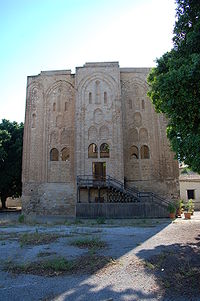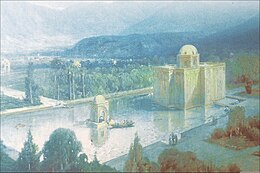Cuba Palace
| Cuba Palace | |
|---|---|
Palazzo della Cuba | |
 | |
 | |
| General information | |
| Status | In use |
| Architectural style | Arab-Norman |
| Location | Sicily |
| Address | Corso Calatafimi 100, 90129 Palermo |
| Town or city | Palermo |
| Country | Italy |
| Current tenants | Museum |
| Completed | 1180 |
| Client | Hauteville family |
| Design and construction | |
| Main contractor | William II of Sicily |
TheCuba(Sicilian:La Cuba) is a recreationalpalacein theSiciliancity ofPalermo,originally part of theSollazzi Regigroup ofNormanpalaces. It was built in 1180 byWilliam II of Sicilyin his Royal Park, together with anartificial lake.[1]The nameCubaderives either from its cubical form, or the ArabicQubba,"dome". It is an imitation of theZisa palace.[2]In July 2015 it was included in theUNESCOArab-Norman Palermo and the Cathedral Churches of Cefalù and MonrealeWorld Heritage Site.[3]
It is also called "Cuba sottotana" to distinguish it from theCubula,orLittle Cuba,a small pavilion built by William II for the Genoardo park. The Cuba shows strongFatimid artinfluences, as it was (at least partially) designed by Arab artists still living in Palermo after the Norman conquest.[2]

History[edit]

TheHauteville familyconquered Sicily in1070with the capture of Palermo byRobert Guiscard.The Cuba was built in1180for King William II, in the center of a large park calledJannat al-ard( "Paradise on earth" ), or Genoardo. The Genoardo also included the Cuba soprana and the Cubula, and formed part of the Sollazzi Regi, a circuit of Norman court palaces located around Palermo.
The original use of the Cuba was recreational; the man-made pool served as a natural air-cooling system, for resting during the hottest hours or attending parties and ceremonies in the evening.[4]The Cuba now appears oddly tall, since in the past, it was surrounded by an artificial lake almost eight feet deep. The largest opening, on the northern front, overlooked the water.[1]
In the following centuries, Cuba would see various uses. The lake was drained and pavilions were built on the banks, and it was used as a lazaretto during theplague of 1576to 1621. During the rule ofBourbon kings of Naplesit was annexed to a barracks.[4]The Cuba finally became state property in 1921. Officially passed to theRegione Siciliana,in the 1980s restoration began on the 12th century structures. In 2015, it was approved as aUNESCO World Heritage Site.[3]
Structure[edit]

Constructed in limestone brick, the building has a rectangular shape, 31.15 meters long and 16.80 wide. Four tower-shaped facades protrude from the center of each side. The most protruding facade was the only access to the building from the mainland. The external walls are decorated withogivalarches, and the cornice is inscribed with bands of Arabic calligraphy. A large dome surmounts the central area of the palace.[1]
The thick walls and the few windows were due to climatic needs, offering greater resistance to the heat of the sun. Furthermore, the largest cluster of open windows was on the north-eastern side, to better receive the fresh winds from the sea, further humidified by the waters of the surrounding artificial lake.[4]
The interior of the Cuba was divided into three aligned and connected rooms, with no private rooms.[4]At the center are the remains of a marble fountain, a typical element of Arab buildings used to refresh the air. This fountain would have been connected to the outside pool through a subterranean passageway.[1]The central hall was embellished withmuqarnas,an architectural and ornamental solution similar to a half dome.
In fiction[edit]
The Cuba's fame was such thatGiovanni Boccaccioset one of the tales of theDecameron(1353) there — tale V, 6, a love story between Gian di Procida and Restituta.[5]
Bibliography[edit]
- Michele Amari,Storia dei musulmani di Sicilia,Catania, R. Prampolini,. 1933-9, 3 vols in 5 volumes.
- A. Aziz,A History of Islamic Sicily,Edinburgh, 1975.
- F. Gabrieli - U. Scerrato,Gli Arabi in Italia,Milano, Scheiwiller, 1979.
- A. De Simone, "Palermo nei geografi e viaggiatori arabi del Medioevo", in:Studi Magrebini,II (1968), pp. 129–189.
- G. Caronia - V. Noto,La Cuba di Palermo, Arabi e Normanni nel XII secolo,Palermo 1989.
- A. De Simone, "Palermo nei geografi e viaggiatori arabi del Medioevo", in:Studi Magrebini,II (1968), pp. 129–189.
- F. Gabrieli - U. Scerrato,Gli Arabi in Italia,Milano, Scheiwiller, 1979.
- V. Noto,Les palais et les jardins siciliens des rois normands,in: Trésors romans d'Italie du Sud et de Sicile, (1995), pp. 97–108
See also[edit]
- William II of Sicily
- Emirate of Sicily
- Norman conquest of southern Italy
- Cuba bizantina
- Norman–Arab–Byzantine culture
References[edit]
- ^abcd"Archnet > Site > Palazzo della Cuba".archnet.org.Retrieved2023-07-16.
- ^abSkramstad, Erik."Palermo: La Cuba - Wonders of Sicily".The Wonders of Sicily.Retrieved2023-07-16.
- ^ab"Palermo arabo-normanna: cube, castelli e parchi, oltre il sito UNESCO c'e' ancora tanto | OnuItalia".2015-09-28. Archived fromthe originalon 2015-09-28.Retrieved2023-07-16.
- ^abcd"The Castle of Cuba and Punic Necropolis".Visit Sicily | Scopri la Sicilia.Retrieved2023-07-16.
- ^"They All Wanted It - A Journey in Sicily - Palermo: Norman-Arab Monuments".romeartlover.it.Retrieved2023-07-16.
